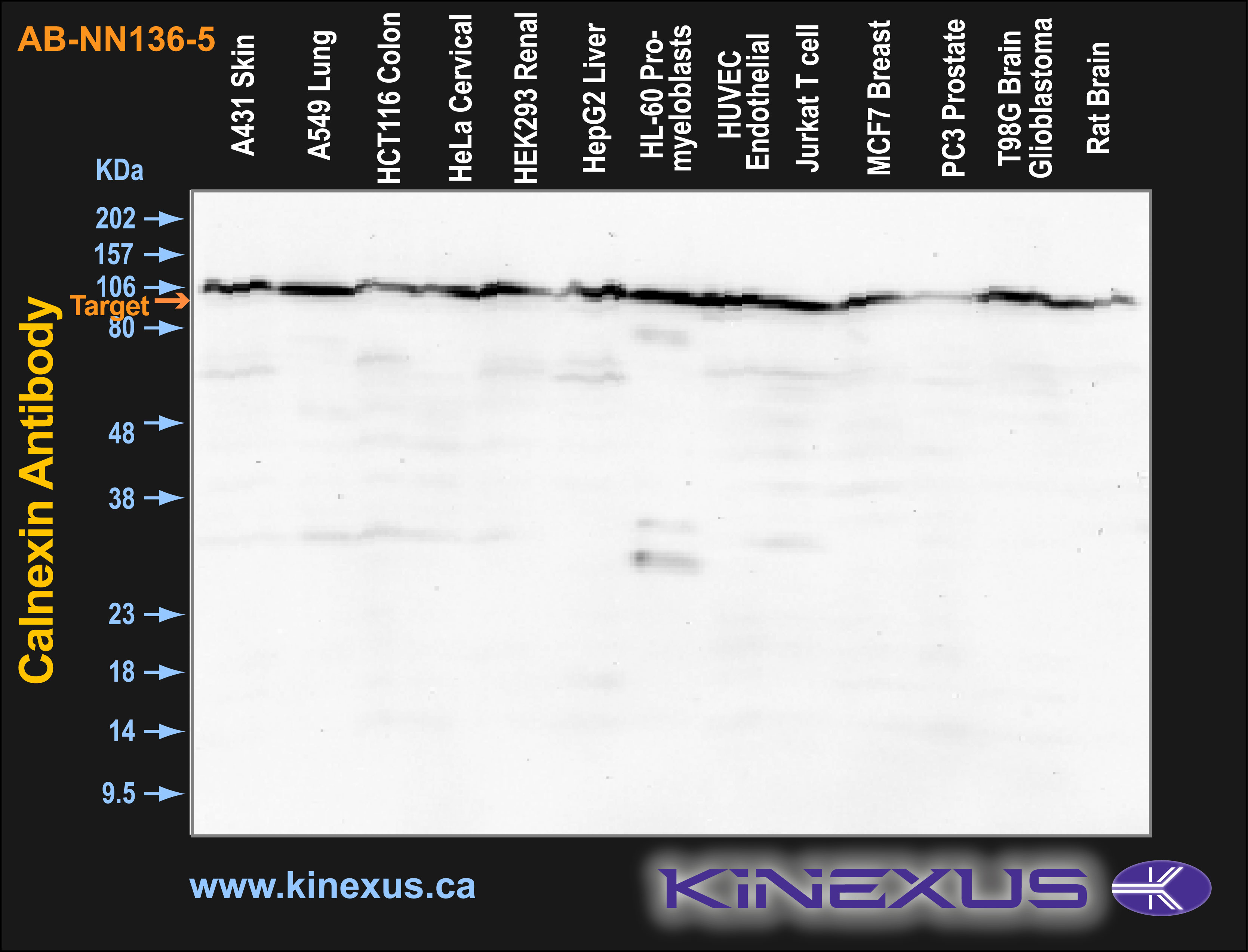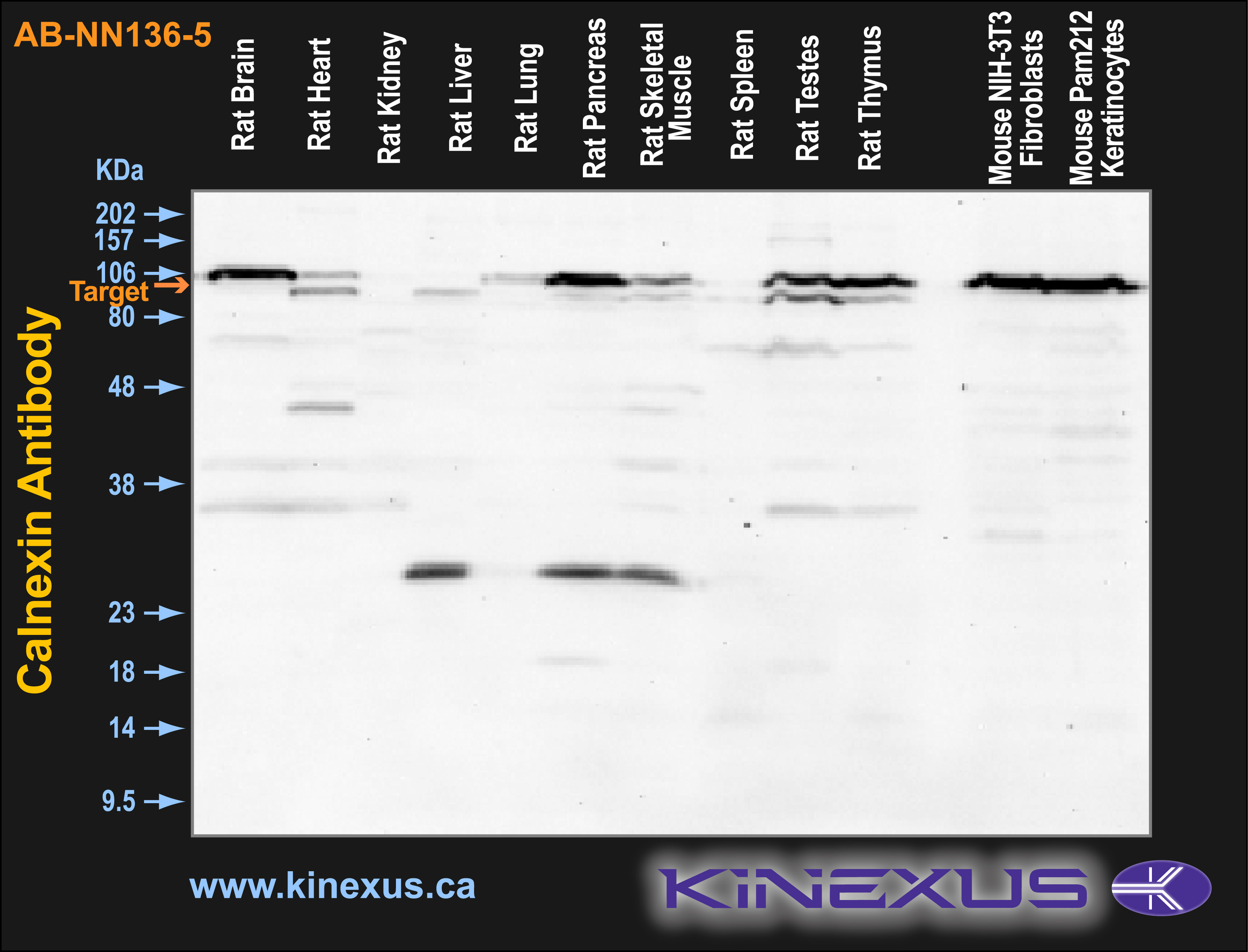Product Name: Calnexin-CT
Product Number: AB-NN136-5
| Size: | 50 µg | Price: | 89.00 | |
| $US |
Target Full Name: Calnexin
Target Alias: CALX_HUMAN; CANX; CNX; FLJ26570; Histocompatibility complex class I antigen binding protein p88; IP90; Major histocompatibility complex class I antigen-binding protein p88
Product Type Specific: Calcium binding protein pan-specific antibody
Antibody Code: NN136-5
Antibody Target Type: Pan-specific
Protein UniProt: P27824
Protein SigNET: P27824
Antibody Type: Polyclonal
Antibody Host Species: Rabbit
Antibody Ig Isotype Clone: N/A
Target Alias: CALX_HUMAN; CANX; CNX; FLJ26570; Histocompatibility complex class I antigen binding protein p88; IP90; Major histocompatibility complex class I antigen-binding protein p88
Product Type Specific: Calcium binding protein pan-specific antibody
Antibody Code: NN136-5
Antibody Target Type: Pan-specific
Protein UniProt: P27824
Protein SigNET: P27824
Antibody Type: Polyclonal
Antibody Host Species: Rabbit
Antibody Ig Isotype Clone: N/A
Antibody Immunogen Source: Dog Calnexin C-terminal synthetic peptide conjugated to KLH. Identical to human, mouse and rat calnexin sequences over these residues.
Production Method: Protein A purified
Antibody Modification: Unconjugated. Contact KInexus if you are interest in having the antibody biotinylated or coupled with fluorescent dyes.
Antibody Concentration: 1 mg/ml
Storage Buffer: Phosphate buffered saline pH7.2, 50% glycerol, 0.09% sodium azide
Storage Conditions: For long term storage, keep frozen at -40°C or lower. Stock solution can be kept at +4°C for more than 3 months. Avoid repeated freeze-thaw cycles.
Production Method: Protein A purified
Antibody Modification: Unconjugated. Contact KInexus if you are interest in having the antibody biotinylated or coupled with fluorescent dyes.
Antibody Concentration: 1 mg/ml
Storage Buffer: Phosphate buffered saline pH7.2, 50% glycerol, 0.09% sodium azide
Storage Conditions: For long term storage, keep frozen at -40°C or lower. Stock solution can be kept at +4°C for more than 3 months. Avoid repeated freeze-thaw cycles.
Product Use: Western blotting | Immunohistochemistry | ICC/Immunofluorescence | Immunoprecipitation | FCM
Antibody Dilution Recommended: WB (1:2000), ICC/IF (1:100), IHC (1:100); optimal dilutions for assays should be determined by the user.
Antibody Potency: High potency. Detects a the C-terminal domain of Calnexin ~90 kDa protein in cell and tissue lysates by Western blotting. Weak detection in Chicken, Drosophila, and Xenopus tissues.
Antibody Species Reactivity: Human | Mouse | Rat | Bovine | Monkey | Chicken | Dog | Guinea pig | Hamster | Pig | Quail | Rabbit | Sheep | Drosophila | Xenopus
Antibody Positive Control: A 1:2000 dilution of SPC-182 was sufficient for detection of Calnexin in 10 µg of HeLa cell lysate by ECL immunoblot analysis.
Antibody Specificity: Medium
Antibody Dilution Recommended: WB (1:2000), ICC/IF (1:100), IHC (1:100); optimal dilutions for assays should be determined by the user.
Antibody Potency: High potency. Detects a the C-terminal domain of Calnexin ~90 kDa protein in cell and tissue lysates by Western blotting. Weak detection in Chicken, Drosophila, and Xenopus tissues.
Antibody Species Reactivity: Human | Mouse | Rat | Bovine | Monkey | Chicken | Dog | Guinea pig | Hamster | Pig | Quail | Rabbit | Sheep | Drosophila | Xenopus
Antibody Positive Control: A 1:2000 dilution of SPC-182 was sufficient for detection of Calnexin in 10 µg of HeLa cell lysate by ECL immunoblot analysis.
Antibody Specificity: Medium
Related Product 1: Calnexin-CT pan-specific antibody (Cat. No.: AB-NN136-4)
Related Product 2: Calnexin-NT pan-specific antibody (Cat. No.: AB-NN136-2)
Related Product 2: Calnexin-NT pan-specific antibody (Cat. No.: AB-NN136-2)
Scientific Background: Calnexin, an abundant ~90kDa integral protein of the endoplasmic reticulum, is also referred to as IP90, p88 and p90 (1). It consists of a large 50kDa N-terminal calcium-binding luminal domain, a single transmembrane helix and a short acidic cytoplasmic tail (2, 3). Unlike its ER counterparts which have a KDEL sequence on their C-terminus to ensure ER retention (4), calnexin has positively charged cytosolic residues that do the same thing (3). Most ER proteins act as molecular chaperones and participate in the proper folding of polypeptides and their assembly into multi-subunit proteins. Calnexin together with calreticulin, plays a key role in glycoprotein folding and its control within the ER, by interacting with folding intermediates via their mono-glycosylated glycans (5, 6). Calnexin has also been shown to associate with the major histocompatibility complex class I heavy chains, partial complexes of the T cell receptor and B cell membrane immunoglobulin (7).
Figure 1. Immunoblotting of various cell lines with AB-NN136-5 at a 1000 x dilution. The target protein Calnexin is indicated. Each lane was loaded with 15 µg of cell lysate protein. The max signal count was 12536.
Figure 2. Immunoblotting of various tissue lines with AB-NN136-2 antibody at a 1000 X dilution. The target protein Calnexin is indicated. Each lane was loaded with 15 µg of tissue lysate protein. The max signal count was 12759.
References
[1] Rajagopalan S., Xu Y., and Brenner M.B. (1994) Science. 263(5145): 387-90.
[2] Tjoelker L.W. et al. (1994) Biochemistry. 33: 3229.
[3] Schrag J. et al. (2001) Molecular Cell. 8(3): 633-644.
[4] Janiszewski M. (2005) J. Biol Chem. 280(49): 40813- 40819.
[5] Elagoz A., Callejo M., Armstrong J., and Rokeach L. A. (1999) J. Cell Sci. 112: 4449-4460.
[6] Otteken A. and Moss B. (1996) J Bio Chem. 271(1): 97-103.
[7] Galvin K. et al. (1992) Proc Natl Acad Sci USA. 89(18): 8452-6.
[1] Rajagopalan S., Xu Y., and Brenner M.B. (1994) Science. 263(5145): 387-90.
[2] Tjoelker L.W. et al. (1994) Biochemistry. 33: 3229.
[3] Schrag J. et al. (2001) Molecular Cell. 8(3): 633-644.
[4] Janiszewski M. (2005) J. Biol Chem. 280(49): 40813- 40819.
[5] Elagoz A., Callejo M., Armstrong J., and Rokeach L. A. (1999) J. Cell Sci. 112: 4449-4460.
[6] Otteken A. and Moss B. (1996) J Bio Chem. 271(1): 97-103.
[7] Galvin K. et al. (1992) Proc Natl Acad Sci USA. 89(18): 8452-6.
© Kinexus Bioinformatics Corporation 2017



